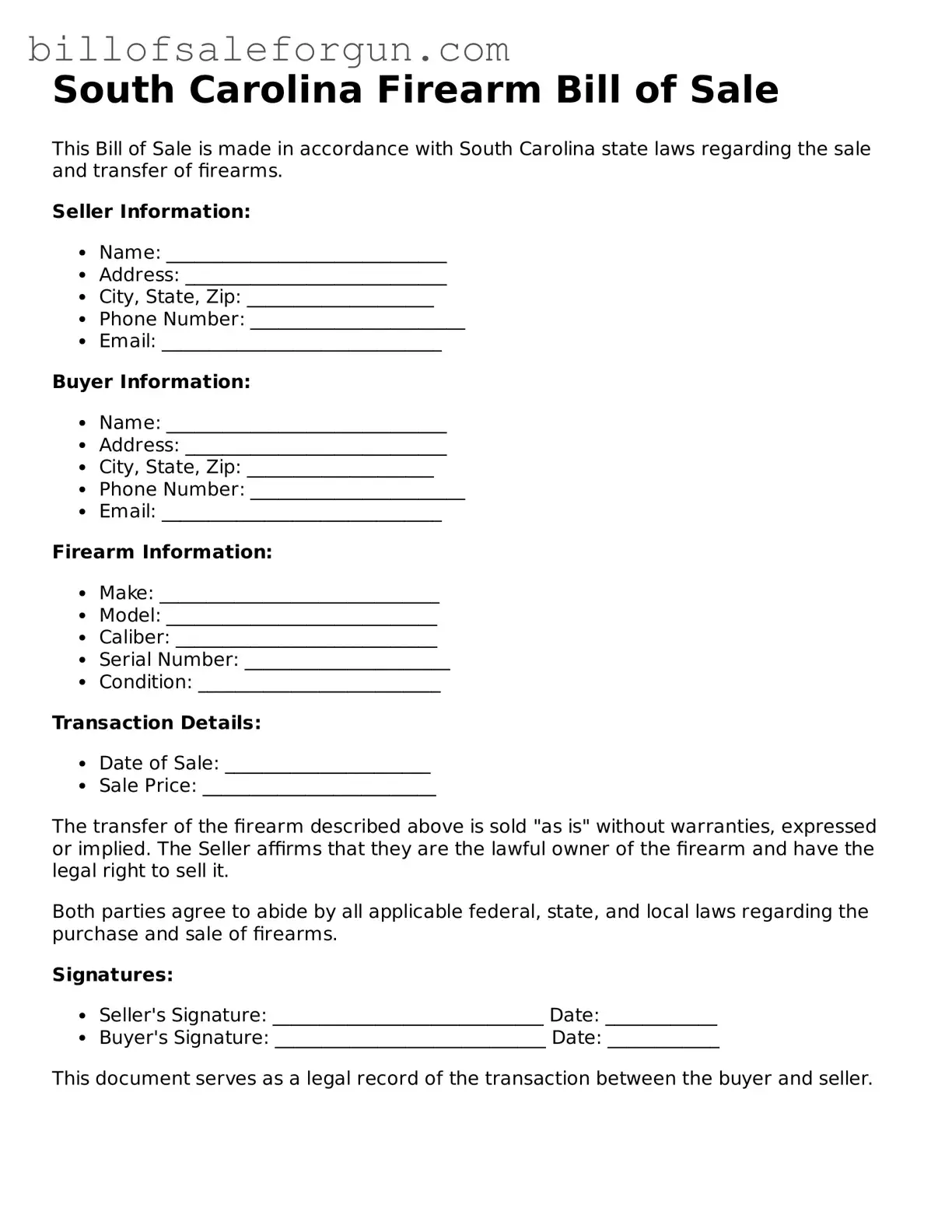Similar forms
The South Carolina Firearm Bill of Sale form shares similarities with a Vehicle Bill of Sale. Both documents serve as a record of a transaction between two parties, detailing the sale of a specific item. In the case of a vehicle, the form includes information such as the buyer and seller's names, the vehicle identification number (VIN), and the purchase price. Just like the firearm bill of sale, this document helps protect both parties by providing proof of ownership transfer and can be used for registration purposes with state authorities.
Another document that resembles the Firearm Bill of Sale is the Boat Bill of Sale. This form is used when selling or purchasing a boat, and it typically includes details about the boat, such as its make, model, and hull identification number (HIN). Similar to the firearm transaction, it outlines the buyer and seller's information and the agreed purchase price. Both documents serve to formalize the sale and provide legal protection in case of disputes.
The Equipment Bill of Sale is also comparable to the Firearm Bill of Sale. This document is used for the sale of various types of equipment, such as tools or machinery. It records essential details about the equipment, including its condition and serial number, along with the buyer and seller's information. Both forms ensure that the transaction is documented and can serve as evidence of ownership transfer in the future.
In addition, the Personal Property Bill of Sale has similarities to the Firearm Bill of Sale. This document is used for the sale of personal items, such as furniture or electronics. It includes the buyer and seller's names, a description of the item, and the sale price. Both documents provide a clear record of the transaction, helping to avoid misunderstandings and disputes later on.
The Lease Agreement can also be likened to the Firearm Bill of Sale in terms of documenting a transaction. While a lease agreement typically involves renting property rather than selling it, both documents outline the terms of the arrangement between the parties involved. They include essential information such as the parties' names, the item or property being leased or sold, and any conditions of the transaction. Both serve to protect the rights of the parties involved.
The Rental Agreement is another document similar to the Firearm Bill of Sale. This agreement outlines the terms of renting an item, such as equipment or vehicles. It includes the names of the parties, rental duration, and payment terms. Just like the Firearm Bill of Sale, it formalizes the transaction and provides a record for both parties, ensuring that all terms are clear and agreed upon.
The Warranty Deed also shares some characteristics with the Firearm Bill of Sale. While a warranty deed is specifically used for transferring real estate, both documents serve to legally document the transfer of ownership. They include information about the parties involved, the item being transferred, and any warranties or guarantees associated with the transaction. Both serve to protect the interests of the buyer and seller.
Additionally, the Promissory Note can be compared to the Firearm Bill of Sale, as both documents involve financial transactions. A promissory note outlines the terms of a loan, including the amount borrowed and repayment schedule. Similar to a firearm sale, it provides a record of the agreement between the parties, ensuring clarity and accountability in the transaction.
The Gift Receipt is another document that bears resemblance to the Firearm Bill of Sale. While a gift receipt is used when transferring ownership without payment, both documents record the transfer of an item from one person to another. They include details about the item and the parties involved, serving as proof of the transaction. Both forms help clarify ownership and can prevent potential disputes.
Lastly, the Affidavit of Ownership is similar to the Firearm Bill of Sale in that it establishes proof of ownership. This document is often used when someone needs to assert their ownership of an item, such as a vehicle or firearm, especially if they do not have a formal bill of sale. Both documents provide a means to verify ownership and can be important for legal purposes.
